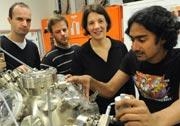World's smallest transistor
UNSW scientists have taken a quantum leap into a new era of computing power by building the world's smallest transistor with just seven atoms.
UNSW scientists have taken a quantum leap into a new era of computing power by building the world's smallest transistor with just seven atoms.

Scientists have taken a leap into a new era of computing power by making the world's smallest precision-built transistor of just seven atoms in a single silicon crystal.
Despite its incredibly tiny size - a mere four billionths of a metre long - the quantum dot is a functioning electronic device, the world's first created deliberately by placing individual atoms.
It can be used to regulate and control electrical current flow like a commercial transistor but it represents a key step into a new age of atomic-scale miniaturisation and super-fast, super-powerful computers.
The discovery was reported this week in the journal Nature Nanotechnology by a team from the UNSW Centre for Quantum Computer Technology (CQCT) and the University of Wisconsin-Madison.
"This is a huge technological achievement and it is a critical step to demonstrating that it is possible to build the ultimate computer - a quantum computer in silicon," says co-author Professor Michelle Simmons, Director of the CQCT, an Australian Research Council Centre of Excellence.
Professor Simmons' appointment was announced earlier this week by UNSW's Dean of Science, Professor Merlin Crossley.
"When you've got a world leading research centre like this Quantum Computing group you want the best possible researcher and research leader as the Director," he said.
"I am delighted that the centre is in the hands of Michelle Simmons, who has won two successive Federation Fellowships, and has consistently been an inspirational figure behind much of the Centre's work."
She replaces Professor Robert Clark, following his appointment as the Australian Government's Chief Defence Scientist.
Read the full story at the Faculty of Science newsroom.
Media contacts: Michelle Simmons | michelle.simmons@unsw.edu.au | UNSW Faculty of Science media liaison - Bob Beale | 0411 705 435 | bbeale@unsw.edu.au